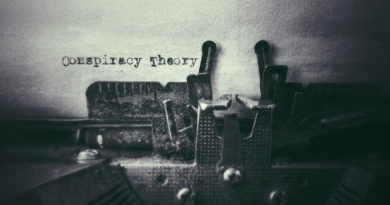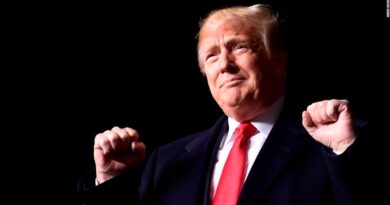On Tupac Shakur, The Notorious B.I.G. and the anatomy of a conspiracy theory
American society’s obsession with celebrity unsurprisingly carries an even deeper fascination with death and conspiracy.
That was obvious July 17, when Las Vegas police raided the home of Duane “Keefe D” Davis for possible connections to the 1996 slaying of Tupac Shakur.
The question of who killed Shakur – and The Notorious B.I.G. six months later – go far beyond hip-hop. Their stories involve all the major strands of American celebrity culture: young, charismatic stars, miscommunication used as entertainment, music industry manipulation, a ruptured friendship eventually leading to gunfire, and decades of conspiracy theories that try to make sense of it all.
There have been no charges, let alone convictions, in either man’s death. So regardless of who is telling the story — gang member, journalist or detective — one has to always think about how much is fact and how much is (conspiracy) theory.
Russell Poole was the original investigator for the Los Angeles Police Department into The Notorious B.I.G.’s slaying. His investigation surmised that not only did Death Row Records founder and CEO Suge Knight have a role in both Shakur’s and The Notorious B.I.G.’s slayings, but also that Los Angeles Police Department officers were working off-duty for Knight. Poole retired in 1999 — he said it was involuntary, and the department said it was a mutual decision — but remained tied to both cases until his death in August 2015. His investigation and a subsequent book became the basis of the 2018 film City of Lies in which Johnny Depp portrayed Poole.
Another Los Angeles Police Department investigator, Greg Kading, led a special task force looking into the The Notorious B.I.G.’s case between 2006-09. Before his team could finish presenting their findings, Kading was removed because of an internal affairs investigation for making false statements in a separate case. He was eventually exonerated, but retired from the department and the task force was disassembled. he, too, is no disinterested observer. Whether intentionally or not, Kading has become a minor celebrity because of what he alleges.
I spoke with Kading in 2020 for my book, It Was All a Dream: Biggie and the World That Made Him. Kading addressed the multiple conspiracy theories around the slayings, especially that both men were the victims of organized hits: that Shakur, the son of a Black Panther, Afeni Shakur, was monitored by the government essentially from the moment he was born, and had to have been slain by some higher force like the federal government. That The Notorious B.I.G. had to have been killed by undercover Los Angeles Police Department cops with ties to Death Row Records.
With no official findings in the quarter century since both slayings, it’s now probably impossible to displace the theories that have permeated the pop culture discourse. In some ways, Kading acknowledged, this is a coping mechanism for losing two artists who meant so much, and still do, to so many. They were only 25 and 24 years old, respectively, when they died and, despite their massive artistic accomplishments, never came close to living their full potential.
“[The Notorious B.I.G.] and Tupac were so big — they were such iconic and unique people and offered so much not only by their lives, but through their music and other creative works,” Kading told me. “The hardest thing people can’t really digest is the idea that two people so influential can die just by some simple, random bulls— violence. That’s the hardest sell because people want to believe that it has to be some larger, maniacal conspiracy theory because only somebody like the government would make their death equal to the people that they were.
“It’s gotta be a big conspiracy because Tupac and Biggie were just too important to die at the hands of some f—ing … gangster.”
Sometimes a lie is easier to accept than the truth. Or, at the very least, an abridged version of the truth. Or, perhaps, in the most charitable sense, our version of the truth. There have been endless examinations of the assassination of President John F. Kennedy. And there are almost as many conspiracy theories purporting to explain the events of Nov. 22, 1963. So much so that the name “Zapruder” has become a verb. The belief that the moon landing in July 1969 was a hoax has only been strengthened by the fact that the last crew landing was over a half-century ago. The 2019 documentary Who Killed Malcolm X? led to the exonerations of Muhammad A. Aziz and Khalil Islam, overturning decades of theories about their reported roles in the assassination. Diana, Princess of Wales, died in 1997, and for nearly just as long many have speculated if her car crash was intentional.
There’s always the desire to believe in “The Plan,” the theory we convince ourselves isn’t just possible, but what happened. Even the most rambunctious of theories — like COVID-19 being a form of population control — has its followers. There is no foundational platform for where the truth lives because we’re conditioned to doubt the institutions that are supposed to be purveyors of legitimacy. It’s the reason why former President Donald Trump can continue to peddle fallacies of a stolen election. Or why Florida governor and Republican presidential hopeful Ron DeSantis invests in the theory that slavery was actually beneficial to slaves. No matter how outrageous the proposition, “truth” in America largely revolves around what provides a person the most comfort. The theories about who was responsible for the killing of Shakur and The Notorious B.I.G. are as American as the Salem witch trials or Colonial-era conspiracy theories regarding the Freemasons.
Kading concluded that both slayings were a result of a murder-for-hire. In Shakur’s case, he argues, Sean “P. Diddy” Combs allegedly paid a bounty for the slaying of either Shakur or Knight stemming from the bitter feud between Knight’s Death Row Records and Combs’ Bad Boy Records. He bases that conclusion on a confession by Davis, who has repeated the same story in several interviews — as recently as an interview posted this week.
Combs repeatedly denied the claims and was never charged.
Regardless of any planning that might have occurred, Shakur’s shooting, though, was by happenstance, Kading said. Had Shakur and Knight never ambushed Orlando Anderson, Davis’ nephew, in that trip to Nevada, there’s a good chance Shakur would be alive today — or, at least, he wouldn’t have been shot in Las Vegas. Davis admitted he was in the car that pulled alongside Knight’s BMW and Anderson opened fire. (Anderson was slain in a Compton car wash shooting in 1998.) Shakur involved himself in gang-related politics by jumping Anderson, who was involved in a brawl at a Los Angeles mall months earlier.
“The gangbanging from the hood, and touching Orlando — he shouldn’t have done that,” said former Death Row Records muscle Mob James. “It was people from Compton there that knew who Orlando was. If they wanted to take off on him, that’s what they should’ve did. Not Tupac.”
The Notorious B.I.G. was allegedly killed by a man named Wardell “Poochie” Fouse, a well-known hitman of Knight’s. The plan was reportedly concocted by an incarcerated Knight (for his role in the Anderson assault months earlier), “Theresa Swann,” a former girlfriend and mother of one of Knight’s children (her government name was withheld as part of her deal with investigators) and Fouse for $25,000 — to be split between him and Swann. Fouse was killed in a drive-by shooting in July 2003.
As for Kading’s findings and the Unsolved series, Voletta Wallace, The Notorious B.I.G.’s mother, gave her review in a 2020 interview with The Breakfast Club.
“To be honest with you, I watched it. There’s some things that went on [and] I knew about it,” she said, sitting beside Wayne Barrow, manager of The Notorious B.I.G.’s estate. “But I watched it and I’m glad it was out. I’m glad because 98% of it is the truth.”
So this latest news of a police raid on Davis’ Nevada residence isn’t likely to change the narrative about whether his nephew was the triggerman who killed Shakur. Too much time has passed and too many people have already formulated their own conclusions as to what happened. Rather, the real questions center around the two living participants in what proved to be rap’s deadliest war in Combs and Knight. Answers reside in them which we’ll likely never receive. Knight — who once said he would have signed The Notorious B.I.G. to Death Row Records had he not died — is likely serving the rest of his life in prison. And Combs has denied the claims Davis has levied against him for years.
So the question now is what does truth look like when a judicial resolution is impossible to obtain.
“That’s never gonna happen. Too much time has gone by … too many complicating factors. No one’s gonna get prosecuted. So if a prosecution and conviction is how you evaluate justice, then you’re gonna be unsatisfied,” said Kading.
“Recognizing the people that were involved in Biggie’s murder, what are their lives like? Have they suffered? And is that adequate? You can’t ask for anything more than a life for a life,” Kading told me. “And the individual that killed Christopher was shot in cold blood, 10 times in the back, basically executed the same way Christopher was. So there’s a sense of ‘That’s perfect justice.’ ”
Of the four individuals who were in the car when Anderson allegedly opened fire on Shakur and Knight, only Davis is still alive. Poochie, the reported triggerman in The Notorious B.I.G.’s slaying, has been dead for 20 years. And Theresa Swann has immunity from prosecution, thanks to her deal with Kading. She has to live with her own kids and family, Kading stressed, knowing what she did.
“Is that justice? Probably not,” he said. “Those are the conditions. Those situations. So, you have to ask yourself. What’s just?”
What’s just?
Nearly 50 years into hip-hop’s existence, it’s time to recognize two undeniable truths. The genre lost two of its brightest stars at a pivotal juncture. And that the biggest injustice isn’t that we’ll never get the full story of who killed Shakur and The Notorious B.I.G. It’s that it ever happened in the first place.
“How long will they mourn me?” Shakur once asked.
“You’re nobody until somebody kills you,” The Notorious B.I.G. rapped.

